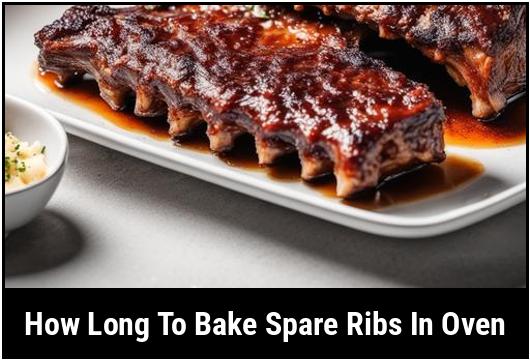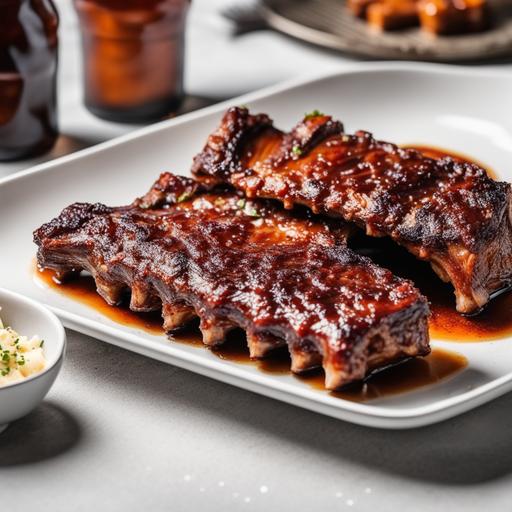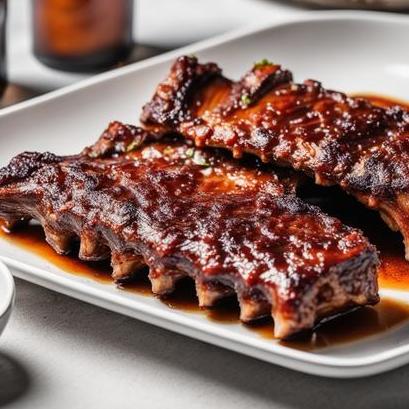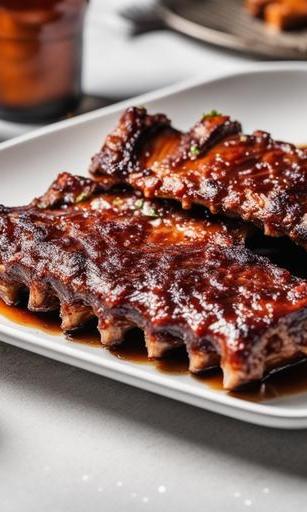[GUIDE] How Long To Bake Spare Ribs In Oven

Baking spare ribs in the oven is a great way to achieve tender, succulent meat that falls off the bone. Spare ribs are a popular choice for barbecue enthusiasts and home cooks alike, thanks to their rich flavor and juicy texture. However, baking spare ribs requires time, precision, and a solid understanding of cooking techniques to achieve the perfect result. In this comprehensive guide, we will walk you through everything you need to know about how long to bake spare ribs in the oven, including the science behind cooking spare ribs, preparation, cooking time, troubleshooting, and serving suggestions.
Quick Answer: How Long To Bake Spare Ribs In The Oven
Baking spare ribs in the oven typically takes around 2.5 to 3 hours at a temperature of 275°F (135°C). However, keep in mind that cooking times can vary depending on the size and thickness of the ribs, as well as the desired tenderness. It’s important to monitor the ribs closely during the cooking process to ensure they are not overcooked or undercooked.
Key Takeaways
- Baking spare ribs in the oven usually takes 2.5 to 3 hours at 275°F (135°C).
- Cooking times may vary depending on the size, thickness, and desired tenderness of the ribs.
- Proper preparation, including marinating or seasoning the ribs, is essential for achieving flavor.
- Using a meat thermometer can help monitor the internal temperature and prevent overcooking.
- Letting the ribs rest for a few minutes after baking helps retain moisture and enhances flavor.
The Science Of Cooking Spare Ribs

To understand how to bake spare ribs in the oven effectively, it’s essential to grasp the science behind cooking them. Spare ribs come from the belly side of the pig, just below the back ribs. These cuts contain more connective tissue, which requires slow, gentle heat to break down and become tender.
When spare ribs are exposed to heat, the collagen in the connective tissues starts to break down. This process, known as collagen denaturation, occurs slowly at lower temperatures but speeds up as the temperature rises. As the collagen melts away, the meat becomes more tender and flavorful.
Additionally, the Maillard reaction takes place during baking. This chemical reaction occurs when proteins and sugars in the meat interact under high heat conditions, resulting in flavorful browning on the surface of the ribs.
Choosing Spare Ribs
When it comes to choosing spare ribs for baking, there are a few factors to consider. Look for ribs with good marbling, as this will impart more flavor and tenderness to the meat. You can choose between baby back ribs, which come from the upper part of the rib cage, or St. Louis-style spare ribs, which are larger and meatier.
It’s also important to select ribs with an adequate amount of meat attached to the bone. Ribs with too much fat or very little meat may not yield the desired result when baked in the oven.
Preparing Spare Ribs
Properly preparing spare ribs before baking is crucial for achieving optimum flavor and tenderness. Here are the steps to follow:
-
Trimming:
- Remove the thin membrane, called the silver skin, from the bone side of the ribs. This membrane can prevent seasonings from penetrating the meat and make the ribs tough.
- To remove the silver skin, slide a butter knife or your fingers between the membrane and meat at one end of the ribs. Lift and loosen the membrane, then grip it with a paper towel and pull it off in one motion.
-
Marinating or seasoning:
- Marinating the ribs can infuse them with additional flavor. You can choose to marinate the ribs overnight in the refrigerator using your favorite marinade or seasoning blend. This step is optional but highly recommended for enhanced taste.
- If you prefer a dry rub, generously season the ribs with a mixture of herbs, spices, and seasonings. Cover the ribs with the rub and let them sit in the refrigerator for at least 30 minutes before baking.
-
Resting:
- If you have marinated or seasoned the ribs, allow them to rest at room temperature for about 30 minutes before placing them in the oven. This allows the flavors to penetrate the meat and ensures more even cooking.
These preparation steps will help you achieve tender, flavorful spare ribs.
Ideal Cooking Temperature For Spare Ribs
Choosing the right cooking temperature is crucial for baking spare ribs to perfection. A moderate and consistent heat allows the collagen to break down gradually, resulting in tender meat.
The ideal oven temperature for baking spare ribs is 275°F (135°C). This temperature ensures that the ribs cook evenly and allows sufficient time for the connective tissues to soften and render.
Spare Ribs Cooking Time

The cooking time for spare ribs primarily depends on their thickness, size, and desired tenderness. Baking spare ribs at a low and slow temperature ensures that they become tender while maintaining their texture.
As a general guideline, baking spare ribs at 275°F (135°C) for approximately 2.5 to 3 hours yields great results. However, it’s important to keep in mind that cooking times may vary. Thicker ribs may require additional time, while thinner ribs may cook faster.
The best way to determine when the ribs are done is to use a combination of visual cues and internal temperature. The meat should easily separate from the bone, and the internal temperature of the thickest part of the meat should reach around 195°F (90°C) for fall-off-the-bone tenderness.
Cooking Techniques
There are different cooking techniques you can try when baking spare ribs in the oven. Let’s explore two popular approaches:
-
Wrapping in foil:
- This technique, often referred to as the "Texas Crutch," involves wrapping the ribs tightly in aluminum foil during part of the cooking process. Wrapping the ribs helps retain moisture, speeds up the cooking time, and enhances tenderness.
- To use this technique, preheat the oven to 275°F (135°C) and place the seasoned ribs on a large sheet of aluminum foil. Fold the sides of the foil over the ribs and crimp the edges to create a tight seal.
- Bake the wrapped ribs for approximately 2 hours, then unwrap them and return them to the oven for an additional 30 minutes to develop a caramelized crust.
- Remember to check the internal temperature to ensure the ribs are cooked to the desired level of tenderness.
-
Two-stage cooking:
- This method involves cooking the ribs at a low temperature initially, then increasing the heat to achieve a flavorful crust.
- Preheat the oven to 275°F (135°C) and bake the ribs uncovered for approximately 2 hours. This slow cooking allows the collagen to break down gradually.
- After 2 hours, increase the oven temperature to 400°F (200°C) and cook the ribs for an additional 15-20 minutes to develop a crispy outer layer.
- Keep a close eye on the ribs during the high-heat stage to avoid burning them.
Monitoring And Troubleshooting
To ensure your spare ribs turn out perfectly, it’s important to monitor them closely during the baking process. Here are some tips for troubleshooting common issues:
- Dry meat: If your spare ribs turn out dry, it could be due to overcooking. Consider reducing the cooking time slightly by 15-30 minutes and checking the ribs for tenderness and juiciness earlier.
- Tough meat: Tough ribs may be a result of undercooking. Adjust the cooking time accordingly and keep the ribs in the oven until they easily separate from the bone without excessive force.
- Uneven cooking: If you notice that the ribs are cooking unevenly, rotate the baking sheet or rack halfway through the cooking process. This ensures that all sides of the ribs receive equal heat exposure.
- Inconsistent tenderness: If you have thicker and thinner ribs on the same rack, you may find that they cook at different rates. In this case, consider cutting the rack into individual portions before baking to achieve consistent tenderness.
Additionally, using a meat thermometer is highly recommended to check the internal temperature of the ribs accurately. This helps prevent both undercooking and overcooking, ensuring tender and juicy meat.
Spare Ribs Cooking Instructions
Here is a step-by-step guide that combines the techniques mentioned above for baking spare ribs in the oven:
-
Preparation:
- Trim the ribs by removing the silver skin from the bone side.
- Marinate the ribs overnight or season them with a dry rub, allowing them to rest at room temperature for 30 minutes.
-
Preheat the oven:
- Preheat your oven to 275°F (135°C).
-
Cook the ribs:
- Place the seasoned ribs on a baking sheet or a wire rack set inside a baking dish.
- Bake the ribs in the preheated oven for approximately 2 hours, uncovered.
- After 2 hours, increase the oven temperature to 400°F (200°C) and cook for an additional 15-20 minutes to develop a crispy crust.
- Alternatively, you can wrap the ribs tightly in aluminum foil after the initial 2-hour cooking period. Bake for an additional 30 minutes, then unwrap the foil and return them to the oven at 400°F (200°C) for a final 15-20 minutes.
-
Check for tenderness:
- To ensure the ribs are done, use a meat thermometer to check the internal temperature. It should read around 195°F (90°C) in the thickest part of the meat.
- Additionally, check if the meat easily separates from the bone. If it does, the ribs are ready. If not, give them a bit more time.
-
Rest and serve:
- Let the ribs rest for about 5 minutes before serving. This allows the juices to redistribute and ensures the meat remains moist.
- Serve the spare ribs with your favorite barbecue sauce or glaze, if desired.
Variations

While the above instructions provide a basic framework for baking spare ribs in the oven, there are numerous variations you can explore to tailor the recipe to your preferences:
- Smoked flavor: If you crave a smoky flavor, you can add an extra layer of complexity by using a smoker. Follow the same preparation and cooking steps, but use a smoker instead of an oven. This will infuse your spare ribs with a delicious smoky taste.
- Different seasonings: Experiment with different spice blends and seasonings to customize the flavor of your ribs. Whether you prefer a sweet and tangy glaze, a spicy dry rub, or a combination of both, feel free to get creative with the seasonings.
- Barbecue sauce: While the ribs are delicious on their own, you can also add a finishing touch by brushing them with your favorite barbecue sauce during the last 15-20 minutes of baking. This adds a rich and tangy element to the already flavorful ribs.
Feel free to adapt the recipe and make it your own by incorporating these variations.
When Things Go Wrong
Even with careful preparation and monitoring, things may not always go as planned when baking spare ribs. Here are some common problems you may encounter and how to address them:
- Burnt crust: If the crust appears burnt during the high-heat stage, reduce the oven temperature slightly or shorten the duration of the high-heat cooking.
- Tough meat: If the meat is still tough after the recommended cooking time, return it to the oven, lower the temperature to 250°F (120°C), and continue baking until it reaches the desired tenderness.
- Dry meat: If the meat is dry, it may have been overcooked. Consider reducing the overall cooking time by 15-30 minutes or try using the foil-wrapping technique to retain moisture.
Remember, practice makes perfect. It may take a few attempts to find the ideal cooking time and temperature that suit your preferences and oven.
Serving Spare Ribs
Once your spare ribs are cooked to perfection, it’s time to serve them. Here are some serving suggestions:
- Sauce and glaze: Brush your baked spare ribs with a generous amount of your favorite barbecue sauce or glaze before serving. This adds another dimension of flavor and moisture.
- Garnish: Sprinkle freshly chopped herbs, such as parsley or cilantro, over the ribs for a pop of freshness and color.
- Side dishes: Spare ribs pair well with a variety of side dishes. Consider serving them with coleslaw, cornbread, roasted vegetables, baked beans, or mashed potatoes.
Best Practices For Spare Ribs Cooking
To achieve the best results when baking spare ribs in the oven, consider the following tips:
- Plan ahead: Spare ribs require a significant amount of cooking time, so plan accordingly. Start preparing them well in advance to ensure you have enough time for marinating, cooking, and resting.
- Use a meat thermometer: A reliable meat thermometer is a valuable tool when baking spare ribs. It allows you to monitor the internal temperature, ensuring the perfect level of tenderness without overcooking.
- Experiment with seasonings: Spare ribs are versatile and can be enhanced with various seasonings and flavors. Feel free to experiment with different rubs or marinades to find your favorite combination.
- Rest the meat: Letting the ribs rest for a few minutes after baking helps retain their moisture and enhances flavor. This short resting period allows the juices to redistribute and ensures a more enjoyable eating experience.
- Be patient: Baking spare ribs requires patience. The slow and low cooking method yields the best results, ensuring tender meat that falls off the bone. Avoid rushing the cooking process to achieve the best texture and flavor.
Conclusion
Baking spare ribs in the oven can be a rewarding culinary experience. By understanding the science behind cooking spare ribs, properly preparing them, and using the right cooking techniques, you can create succulent and flavorful ribs that will impress your family and guests.
Remember to experiment with variations and seasonings to customize the flavor profile to your preference. By following the guidelines outlined in this comprehensive guide, you will be well on your way to mastering the art of baking spare ribs in the oven. Enjoy your delicious journey!
FAQS
What Temperature Should I Set My Oven To When Baking Spare Ribs?
It is recommended to preheat your oven to 325°F (165°C) before baking spare ribs.
How Long Should I Bake Spare Ribs In The Oven?
The length of time it takes to bake spare ribs in the oven will depend on a number of factors, such as the size of the ribs and whether they are bone-in or boneless. In general, 2½ to 3 hours of baking time is needed for spare ribs to become tender and properly cooked.
Should I Cover The Spare Ribs While Baking In The Oven?
It is best to cover the spare ribs with aluminum foil while baking them in the oven. This will keep them from drying out and will help them to remain moist and tender.
How Can I Tell If My Spare Ribs Are Fully Cooked In The Oven?
The preferred method of checking for doneness of the spare ribs is by using a meat thermometer. Insert the thermometer into the thickest part of the rib meat and make sure it reaches a temperature of 145°F (63°C) for at least 15 seconds. Another way to check is by pulling on the bones in the meat, they should slide out easily when the ribs are fully cooked.
In What State Should The Ribs Be Before Baking It In The Oven?
Before baking spare ribs in the oven, it is recommended to prepare them by removing any excess fat, and then seasoning them generously with a dry rub or marinade. Let the ribs sit for at least 1 hour to allow the flavors to fully penetrate the meat.
Sources
About the Author Jenny
I'm Jenny, a housewife with an unwavering passion for food. My culinary journey began with my grandmother's kitchen, and it's now a full-fledged food blog. I've turned my love for cooking into a creative outlet, sharing recipes and stories with a global community of fellow food enthusiasts. It's proof that being a housewife can also mean pursuing your passions and savoring life's delectable moments.
